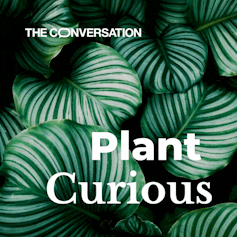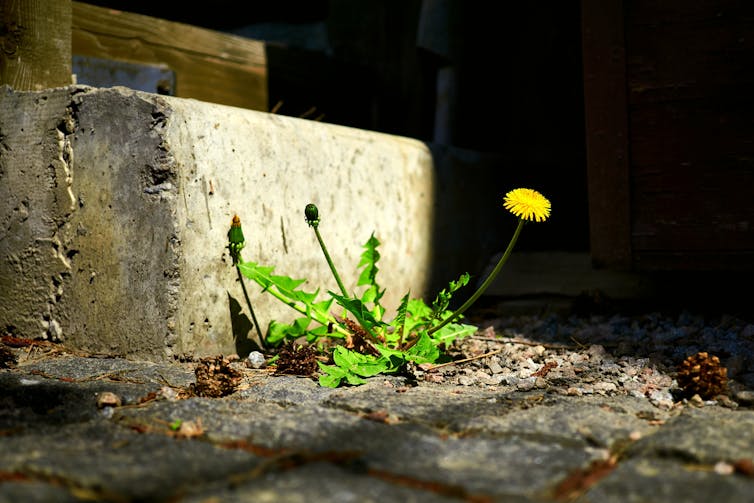The wonderful flowers rising in pavement cracks and why you shouldn’t go them by – The Unconventional Gardener
In spring and summer season flowers pop up spontaneously in lawns, playgrounds, fields and even cracks within the pavement. However what do you see: weeds or wildflowers?
You would possibly really feel a bit annoyed once you see wildflowers rising on the street. Why are they thriving whereas it may be a battle to get backyard flowers to bloom? The easy reply is that they’re wild.
For tens of millions of years, they needed to make do with the solar, soil and rain nature supplied. A windblown seed will land someplace and attempt to germinate, but when the situations are mistaken it won’t survive lengthy. So many wildflowers developed to make hundreds of seeds (equivalent to poppy, creeping thistle, wild carrot and purple deadnettle.
A dandelion (Taraxacum officinale) produces as much as 200 seeds per flower and, on common, 15,000 seeds per plant. In an open discipline, about one-fourth (3,750) of the seeds land in a great place and have the fitting genes to germinate and develop.

Many individuals consider crops as nice-looking greens. Important for clear air, sure, however easy organisms. A step change in analysis is shaking up the way in which scientists take into consideration crops: they’re way more advanced and extra like us than you may think. This blossoming discipline of science is just too pleasant to do it justice in a single or two tales.
This text is a part of a collection, Plant Curious, exploring scientific research that problem the way in which you view plantlife.

House is the place the wall is
Some crops have developed extra elegant techniques to verify their offspring are arrange for fulfillment.
A dandelion seed will go the place the wind, or a toddler’s exhale takes it. The ivy-leaved toadflax (Cymbalaria muralis) takes a bit extra care. Rising on the wall, their small lilac-blue and yellow flowers flip their heads in the direction of the daylight to catch the attention of a passing bee or hoverfly.
As soon as the flower is pollinated and the capsule with seeds begins to develop, the flower turns itself away from the sunshine. Subsequent, it pushes the capsule right into a crevice on the wall. These crevices are the proper place for these seeds to develop. A wall might not sound like a very fertile place, however over time the wind and rain trigger filth and vitamins to get trapped within the pores. That is all of the soil the ivy-leaved toadflax wants.
Sturdy, impartial and beneficiant
Retaining a grass garden completely, uniformly inexperienced is a tricky job and unhealthy for the surroundings, as they don’t present any habitat for pollinators, amongst different causes. Taking part in grounds and different public fields don’t get a lot maintenance, however mysteriously the bottom is inexperienced nonetheless.
Right here, typically white (Trifolium repens) and pink clover (Trifolium pratense) take over the work of the gardener. These crops are the definition of sturdy and impartial. Clovers are drought resistant, keep soil moisture and fertilise the soil.
To fertilise the soil, clovers make little nodules on their roots that are the proper house for rhizobium micro organism. The plant provides the micro organism a pleasant place to dwell whereas the micro organism present the plant with nitrogen.
The clover shares this nitrogen with neighbouring crops by way of their roots and by way of an unlimited community of fungi within the soil. Clover not solely retains a garden inexperienced but in addition gives nectar to pollinators, equivalent to bees, bumblebees, butterflies and moths.
Wildflowers are multitaskers. They’re a supply of meals to your pleasant neighbourhood bugs but in addition profit the soil.
Dandelion gives nectar for over 187 totally different species of untamed bees. Flowers like dandelion, thistle (Cirsium sp.), poppy (Papaver rhoeas) and chicory (Cichoriu intybus) develop taproots which penetrate deep into the bottom and assist them survive harsh situations, equivalent to drought.
Totally different wildflowers develop totally different sorts of roots. Collectively these roots make a nice surroundings for underground life, together with micro organism, fungi and larger critters. These organisms aerate the soil which boosts water regulation. This manner the soil can take in extra water and your puddles will drain extra shortly after a heavy downpour. These crops present many unseen companies to your individual ecosystem.
However are you able to recognise and identify them?
Individuals used to eat all types of wildflowers or use them as medication. For instance, poppies have been, and nonetheless are, used as cough medication and sedative. You may nonetheless purchase chicory root powder as a caffeine-free substitute for espresso.
Wildflowers have lengthy been a part of our cultural heritage as properly. Victorians used wildflowers as items to convey emotions or secret messages. Poppies have been an indication of enjoyment, daisies (Bellis perennis) proclaimed innocence, stinging nettles (Urtica dioica) reported scandals and cornflowers (Centaurea cyanus) whispered of hopes in love.
However we’re shedding our consciousness of the dwelling world round us. The scientific time period plant blindness describes our incapacity to note the crops round us. In a 2010 UK research, teenage college students have been requested to recognise and identify ten frequent wildflowers, however the overwhelming majority couldn’t identify greater than three flowers.
Nevertheless, it has by no means been simpler to study crops. Apps that may recognise crops by way of your cellphone digicam are broadly out there. Some persons are even attempting to share their enthusiasm about wildflowers on the road via botanical chalking – drawing a circle round a plant on the pavement and writing down its identify in chalk.
The following time you see flowers rising via the pavement, why don’t you cease to have a look as an alternative of simply passing by these resilient and delightful wildflowers.
Nienke Beets, PhD Candidate, Botany and Science Communication, Leiden College
This text is republished from The Dialog beneath a Inventive Commons license. Learn the unique article.
Until in any other case acknowledged, © Copyright Emma Doughty 2024. Printed on theunconventionalgardener.com.
For those who loved this submit, please think about supporting my work. I’ve a subscriber-only Patreon for house plant fans, or you might simply purchase me a cup of tea:
Many thanks!



















